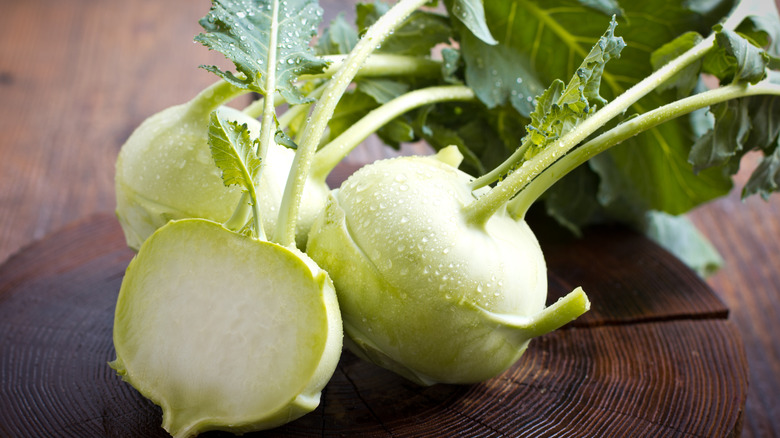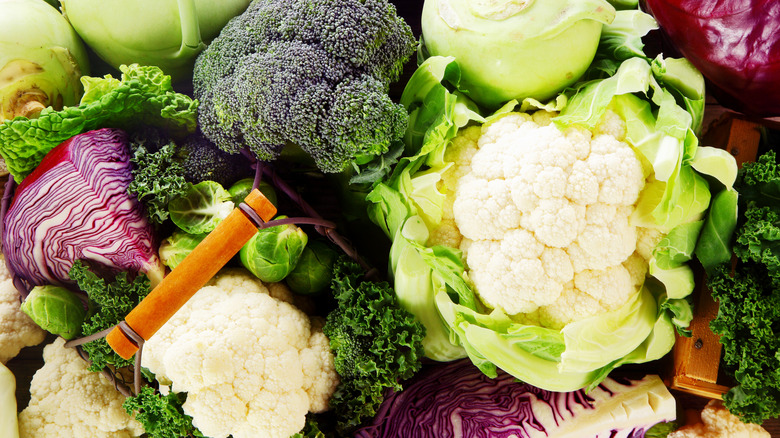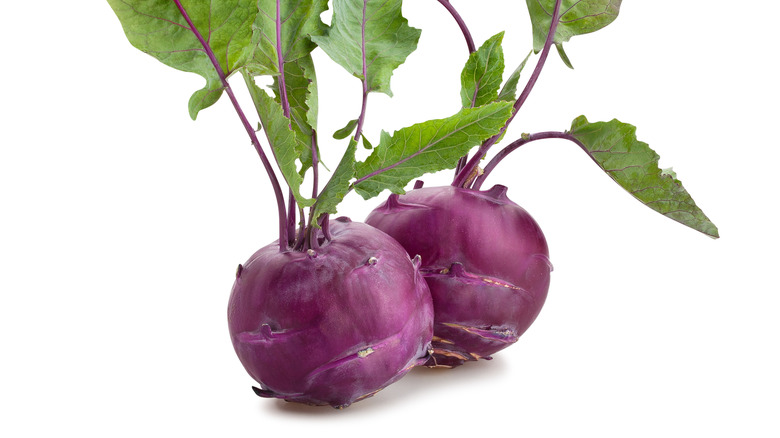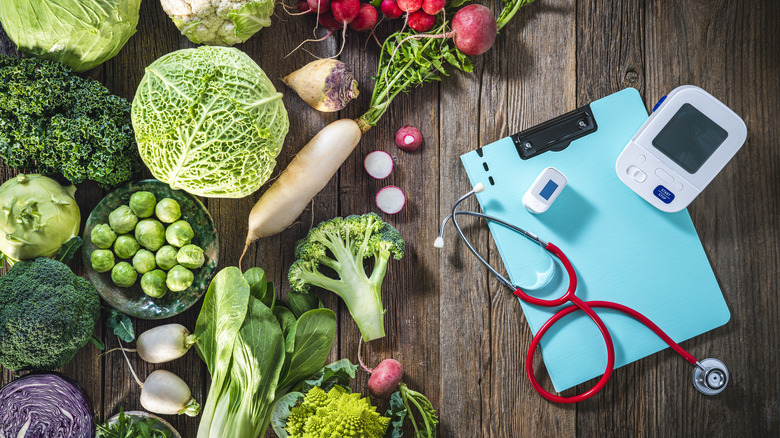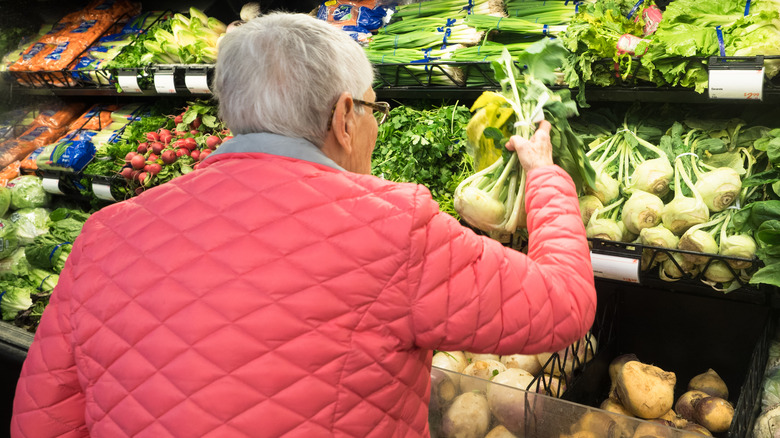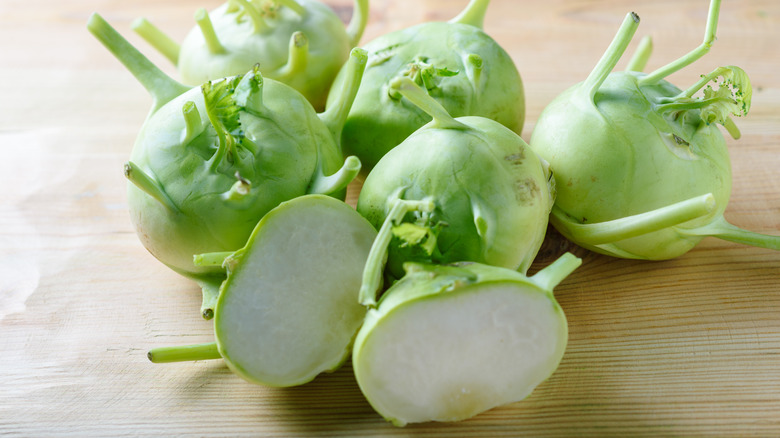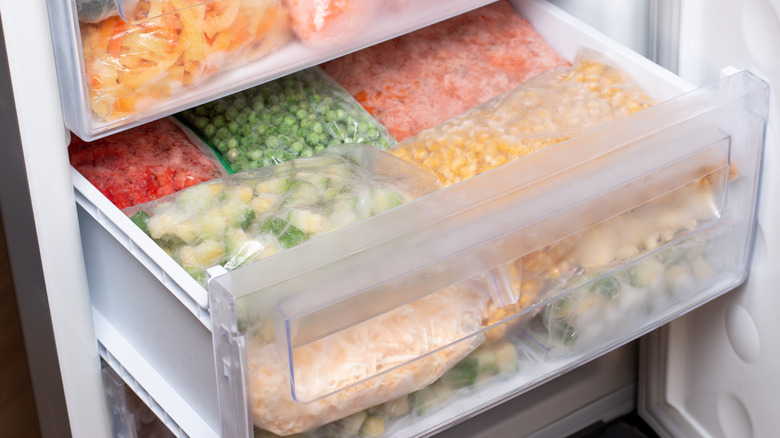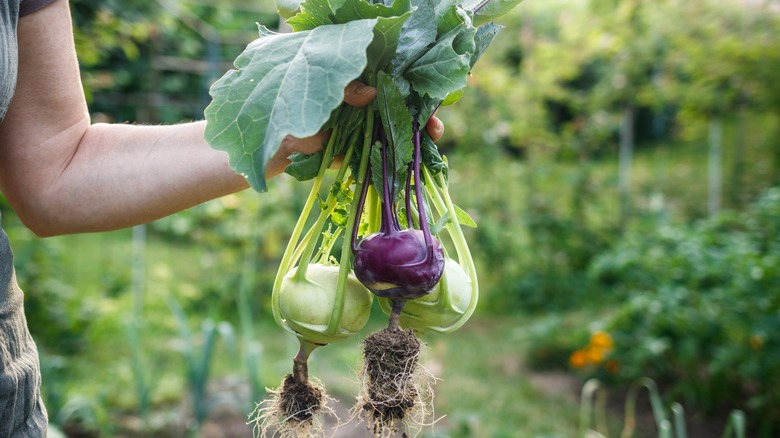What Exactly Is Kohlrabi, And How Can You Use It?
Kohlrabi. It is okay if you haven't heard of it. Kohlrabi is not a vegetable you commonly see at the grocery store. You've also probably not seen a lot of recipes calling for the green, leafy bulb, either. Take a closer look at kohlrabi, however, and you will find an extremely versatile and nutritious vegetable that deserves your attention.
From calcium to vitamin C, kohlrabi is rich in nutrients and vitamins, which make it a powerhouse among its vegetable counterparts. It is also easy to prep, cook, and eat, with its mild flavor lending itself to many recipes. Storing it is also a breeze and the green vegetable stays fresh for weeks. Here's a look at how to pick the best kohlrabi, where to find it, and how to prepare it. Once you fall in love with this lesser-known vegetable, you may even want to start growing it yourself — it is very easy!
What is kohlrabi?
Kohlrabi is a German cabbage. In German, it literally translates to cabbage ("kohl") turnip ("rabi"), due to it looking like both a head of cabbage and a turnip. Despite its name, though, kohlrabi is not related to a turnip, as it is not a root vegetable. Instead, it is a cruciferous vegetable meaning it is more related to cabbage, bok choy, broccoli, kale, and cauliflower. Due to its versatility and nutritional value, it is a powerhouse food that is a beneficial addition to your diet. The majority of the plant is edible, including its leaves.
Kohlrabi thrives in colder weather, and you will find it growing in Eastern Europe, most notably Germany, and Asia. In the United States, it grows mostly in the northern states, such as New York, Michigan, and Wisconsin between fall and spring. Kohlrabi grows quickly and is fairly easy to plant and pick. The vegetable has the texture of an apple, but as it grows the bulb develops a woody and tough texture. Kohlrabi is either green or purple, with the purple variety being a tad sweeter than the green variety.
What does kohlrabi taste like?
Since Kohlrabi is a cruciferous vegetable, it tastes similar to cabbage but with a little kick to it, like a radish. Smaller kohlrabi bulbs tend to be sweeter, crispier, and juicier than those that are larger. Purple kohlrabi is slightly sweeter than its green counterpart.
Eating kohlrabi raw will taste similar to broccoli with the texture of an apple or jicama. Raw is how this YouTube video creator enjoys it, calling it the absolute "best way to eat it. It is delicious," he describes. "It has a taste like broccoli stems, so it would be awesome in a salsa, or slaw, or add it to any salad."
In its raw form, kohlrabi adds a big crunch to recipes. When cooked, the versatile vegetable becomes softer in texture. You can spiral the bulb into noodles, then cook to al dente for a healthy pasta alternative. Similar to a potato, the longer you cook kohlrabi, the softer it gets to the point where it's easy to mash.
What are the nutritional benefits of kohlrabi?
Kohlrabi is low in calories, but high in nutrients and vitamins, making it an extremely healthy vegetable. One cup has less than 40 calories and more than 90% of your daily vitamin C needs. The vegetable also has a high amount of calcium and magnesium, both of which can help improve bone density. It is also packed with folate, which studies show can help prevent certain birth defects related to a baby's brain and spinal cord, according to the Centers for Disease Control and Prevention.
Each cup of kohlrabi has 5 grams of fiber, which aids in digestion, balances sugar levels, and lowers cholesterol. It is also high in potassium, a vitamin proven to have heart benefits, and includes carotenoids and other antioxidants to prevent cancer and other diseases, as well.
Kohlrabi is an excellent alternative to a potato because it is significantly lower in carbohydrates. One potato can have 20 to 30 carbohydrates, whereas one cup of Kohlrabi only has about 8 grams of carbs.
As with any cruciferous vegetables, however, eating too much kohlrabi can lead to excess gas and bloating. This should be temporary and will subside by taking a break from eating the vegetable or taking anti-gas medications. If not, you should see your doctor.
What to look for when buying kohlrabi
Kohlrabi is readily available in Eastern Europe, but can be harder to find in the United States due to its lower popularity here. You may be able to find it more easily in a specialized grocery store or at a local farmer's market. It's easier to find during its peak season, fall to spring, but is available frozenyear-round.
You can buy kohlrabi with its leaves still on (normally at farmer's markets) or with the leaves removed, which is how you'll most likely find it in a grocery store. When buying the vegetable, be sure to feel the bulb ensuring it is firm and does not have any bruises or soft spots. Also, make sure the bulb is smooth and free from cracks or marks. It may seem counterintuitive but look for smaller bulbs as they are sweeter and easier to eat.
How to prep and cook kohlrabi
Whether you plan to eat it raw or cook it, it is very easy to prep kohlrabi. If the stems are still attached, cut them off, but don't discard them; they are edible and can be thrown into a stew or casserole. If the core seems tough, use a small knife to cut it out and throw it away. Next, use a small knife to peel off the outer skin and the top of the bulb, which can both be tough. You can cut the bulb into slices or cubes.
Once cut, you can eat the bulb raw or cook it by steaming, sauteeing, or roasting the kohlrabi. In Germany, kohlrabi is traditionally prepared in a white sauce to serve as a side dish. Just cook the veggie in boiling broth, then mix together flour, butter, nutmeg, and some reserved broth to make the "die Mehlschwitze" sauce, a type of roux.
When cooking kohlrabi leaves, treat them like collard greens or kale. You can add olive oil and salt to them, wilt them down, then throw them into a stew as an alternative to spinach, or eat them raw as part of a salad base.
Juicing the bulb and leaves is also a healthy option. Cut it into small pieces and throw in all your other favorite ingredients too. This green juice recipe is an easy one that you can use kohlrabi in place of other greens, like kale and spinach, or in addition to them for a seriously nutritious drink.
How to store kohlrabi
Once sliced, the kohlrabi bulb will stay fresh in the refrigerator uncovered for up to a month but will lose its crispiness over time. While the taste will remain the same, if you are planning to serve it raw, it's best to use it as soon as possible to ensure the best texture. The leaves will not stay as long, typically wilting within a day or two. For longevity, loosely wrap the leaves and place them in a plastic bag. Both the bulb and the leaves will stay the longest in the refrigerator's crisper.
You can also freeze the different parts of the kohlrabi vegetable. To freeze the bulb, cut it into cubes, then blanch it in water for about a minute , which will also help keep its vibrant color, before packaging and freezing. You can also freeze the leaves. After washing them thoroughly, blanch them, squeeze out excess water, then place them into freezer bags. Keep in mind when the leaves freeze, they will do so in one large block. To prevent having to thaw out the entire mass of leaves, consider freezing them in smaller portions so you can grab the amount you need and just thaw that amount.
How to grow kohlrabi
If you're sold on the mighty cabbage-like vegetable kohlrabi, you will be happy to know it is easy to grow. It's best to plant the seeds in mid- to late July, as they take about two months to grow, and you'll want to harvest them before the ground freezes. Plant the seeds no more than half an inch deep in rows about 6 to 12 inches apart. Make sure to water the soil, but be careful not to overwater the area, as that can harm the seeds. To properly grow, kohlrabi needs about six hours of sunlight per day and will need protection from intense wind and insects during its infancy.
Harvest the kohlrabi bulb when it is about 2 or 3 inches in diameter. You can harvest the leaves at any time while the bulb is growing, but be sure to leave at least one-third of the leaves intact so photosynthesis can continue and the bulb will continue to grow. Cutting away all the leaves will essentially kill the entire plant.
